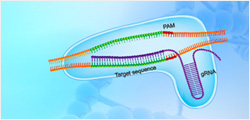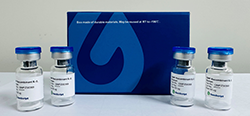| Species |
Human |
| Protein Construction |
HVEM (Leu39-Lys184)
Accession # Q92956 |
hFc |
| N-term |
C-term |
|
| Purity |
> 95% as analyzed by SDS-PAGE
> 95% as analyzed by HPLC |
| Endotoxin Level |
< 0.2 EU/μg of protein by gel clotting method |
| Biological Activity |
Assay #1: ED50 < 0.1 μg/ml, measured by the neutralization assay using 929 cells in presence of 0.25 ng/ml of human TNF-beta, corresponding to a specific activity of > 1.0 × 104 units/mg.
Assay #2: Immobilized HVEM, hFc, Human at 2.0 μg/ml (100 μl/well) can bind biotinylated human BTLA.
Assay #3: Immobilized HVEM, hFc, Human at 2.0 μg/ml (100 μl/well) can bind biotinylated CD160, hFc, Human (Cat. No.: Z03449). |
| Expression System |
Sf9 insect cells |
| Apparent Molecular Weight |
~45 kDa, on SDS-PAGE under reducing conditions. |
| Formulation |
Lyophilized after extensive dialysis against PBS. |
| Reconstitution |
It is recommended that this vial be briefly centrifuged prior to opening to bring the contents to the bottom. Reconstitute the lyophilized powder in ddH?O up to 100 μg/ml. |
| Storage & Stability |
Upon receiving, this product remains stable for up to 6 months at lower than -70°C. Upon reconstitution, the product should be stable for up to 1 week at 4°C or up to 3 months at -20°C. For long term storage it is recommended that a carrier protein (example 0.1% BSA) be added. Avoid repeated freeze-thaw cycles. |
| Target Background |
Herpes Virus Entry Mediator (HVEM) is a transmembrane protein that is the receptor for TNFSF14 (also known as LIGHT) and is therefore referred to asTNFRSF14. HVEM is expressed broadly on immune cells such as T cells, natural killer (NK) cells and monocytes. The interaction of 3 molecules of LIGHT with three molecules of HVEM forms a hexameric complex that leads to the recruitment and retention of effector cells and activates NK cells to produce large amounts of IFN-γ and GM-CSF. In addition to the canonical binding partner LIGHT, HVEM can also bind to the inhibitory signaling protein, B- and T- lymphocyte attenuator (BTLA), which suppresses immune responses. Therefore, the HVEM network plays an important role in regulating immunity and the behavior of lymphocytes. |
| Synonyms |
TNFRSF14; TR2 |
For laboratory research use only. Direct human use, including taking orally and injection and clinical use are forbidden.




































